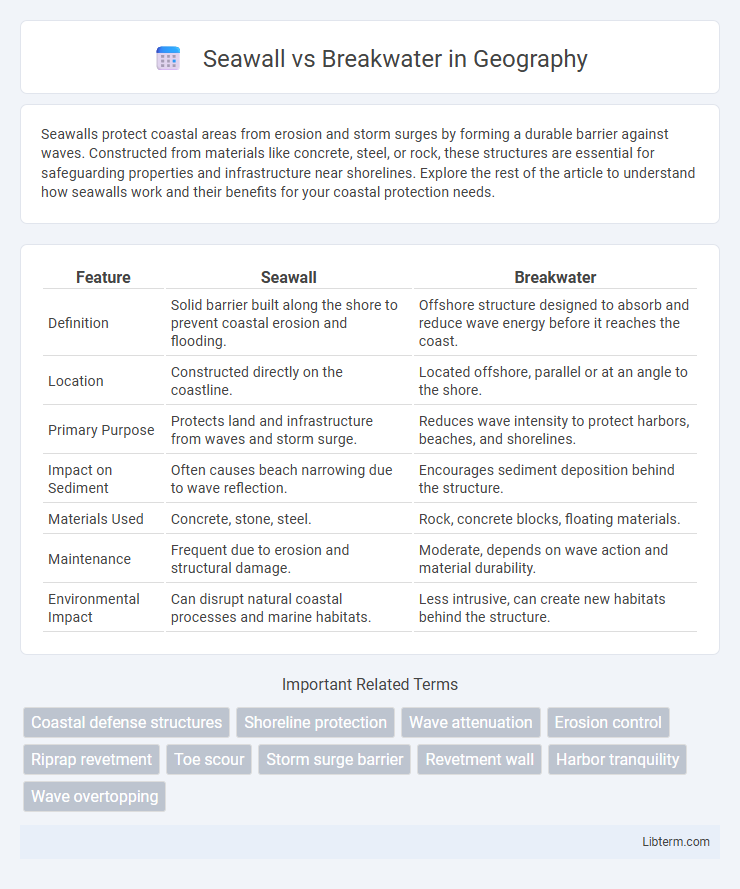Seawalls protect coastal areas from erosion and storm surges by forming a durable barrier against waves. Constructed from materials like concrete, steel, or rock, these structures are essential for safeguarding properties and infrastructure near shorelines. Explore the rest of the article to understand how seawalls work and their benefits for your coastal protection needs.
Table of Comparison
| Feature | Seawall | Breakwater |
|---|---|---|
| Definition | Solid barrier built along the shore to prevent coastal erosion and flooding. | Offshore structure designed to absorb and reduce wave energy before it reaches the coast. |
| Location | Constructed directly on the coastline. | Located offshore, parallel or at an angle to the shore. |
| Primary Purpose | Protects land and infrastructure from waves and storm surge. | Reduces wave intensity to protect harbors, beaches, and shorelines. |
| Impact on Sediment | Often causes beach narrowing due to wave reflection. | Encourages sediment deposition behind the structure. |
| Materials Used | Concrete, stone, steel. | Rock, concrete blocks, floating materials. |
| Maintenance | Frequent due to erosion and structural damage. | Moderate, depends on wave action and material durability. |
| Environmental Impact | Can disrupt natural coastal processes and marine habitats. | Less intrusive, can create new habitats behind the structure. |
Introduction to Coastal Protection Structures
Seawalls and breakwaters are critical coastal protection structures designed to prevent erosion and reduce the impact of wave energy on shorelines. Seawalls are vertical or sloping barriers constructed parallel to the shore to reflect wave energy and protect coastal infrastructure. Breakwaters are offshore structures positioned to absorb and dissipate wave energy before it reaches the coast, creating calmer waters behind them for shoreline stabilization.
What is a Seawall?
A seawall is a coastal defense structure designed to prevent erosion and protect shorelines from storm surges and high waves by absorbing and reflecting wave energy. Constructed from durable materials like concrete, stone, or steel, seawalls are typically built parallel to the coastline, forming a barrier between the land and the sea. Unlike breakwaters, which are offshore structures, seawalls are positioned directly on the coast to safeguard properties and infrastructure from direct wave impact.
What is a Breakwater?
A breakwater is a coastal structure designed to protect shorelines, harbors, and anchorages from the force of waves by creating a calm water area behind it. Constructed from materials such as rock, concrete, or steel, breakwaters absorb and deflect wave energy to prevent erosion and stabilize navigation channels. Unlike seawalls, which are typically built directly on the shore, breakwaters are often positioned offshore to reduce wave impact before it reaches the coast.
Key Differences: Seawall vs Breakwater
Seawalls are vertical structures built along shorelines to prevent coastal erosion and protect infrastructure from wave impacts, whereas breakwaters are offshore barriers designed to absorb and deflect wave energy before it reaches the coast. Seawalls provide direct protection by reflecting wave energy, often resulting in increased erosion at their base, while breakwaters reduce wave intensity, promoting sediment deposition and shoreline stabilization. The primary difference lies in their placement and function: seawalls protect the land directly behind them, and breakwaters safeguard larger coastal areas by modifying wave patterns.
Advantages of Seawalls
Seawalls provide robust coastal protection by effectively preventing erosion and flooding in high-risk areas, offering a strong barrier against wave impact compared to breakwaters. Their vertical structure allows for maintenance of beach width and shoreline stability, which is crucial for urban waterfronts and infrastructure defense. Constructed from durable materials like concrete and steel, seawalls also require less maintenance over time, making them a cost-effective solution for long-term coastal management.
Advantages of Breakwaters
Breakwaters provide superior protection against strong waves and storm surges by dissipating wave energy before it reaches the shore, reducing coastal erosion significantly. They create calm water zones that enhance safe navigation and harbor operations, benefiting maritime activities and local economies. Unlike seawalls, breakwaters can foster marine biodiversity by acting as artificial reefs, supporting aquatic ecosystems.
Environmental Impact: Seawall vs Breakwater
Seawalls often cause increased coastal erosion and habitat loss by reflecting wave energy back into the sea, disrupting natural sediment transport and marine ecosystems. Breakwaters, positioned offshore, reduce wave energy more gradually, promoting sediment deposition and providing habitats for marine life, though they can alter local water circulation patterns. Both structures significantly impact surrounding environments, but breakwaters tend to support greater biodiversity and reduced erosion compared to seawalls.
Cost Comparison: Seawall vs Breakwater
Seawalls generally involve higher initial construction costs due to the use of reinforced concrete and the need for deep foundations to withstand wave impact, averaging $1,500 to $3,000 per linear foot. Breakwaters, often constructed from rock armor or rubble mound, typically have lower upfront expenses, ranging from $1,000 to $2,500 per linear foot, but may require more frequent maintenance. Long-term cost considerations also favor seawalls for urban coastal protection as they provide consistent wave deflection, whereas breakwaters, although less expensive initially, may incur higher repair costs from storm damage over time.
Choosing the Right Solution for Your Coastline
Seawalls provide robust coastal defense by reflecting wave energy and preventing erosion, ideal for urban shorelines with limited space. Breakwaters act as offshore barriers that dissipate wave force before reaching the coast, promoting sediment accumulation and natural beach nourishment. Evaluating factors such as wave intensity, shoreline slope, ecological impact, and long-term maintenance costs ensures the most effective solution for preserving your coastline.
Future Trends in Coastal Defense Structures
Future trends in coastal defense structures emphasize adaptive designs integrating seawalls and breakwaters with natural habitats to enhance resilience against rising sea levels and intensified storms. Innovations in materials, such as self-healing concrete and eco-friendly composites, aim to increase durability while minimizing environmental impact. The integration of smart monitoring systems and modular configurations enables real-time damage assessment and rapid repairs, ensuring long-term coastal protection.
Seawall Infographic

 libterm.com
libterm.com